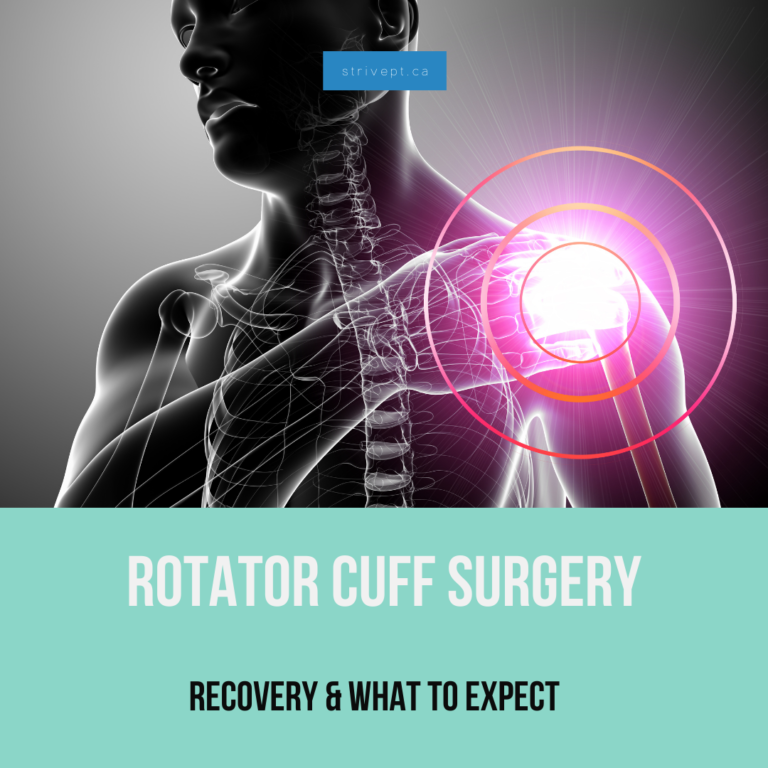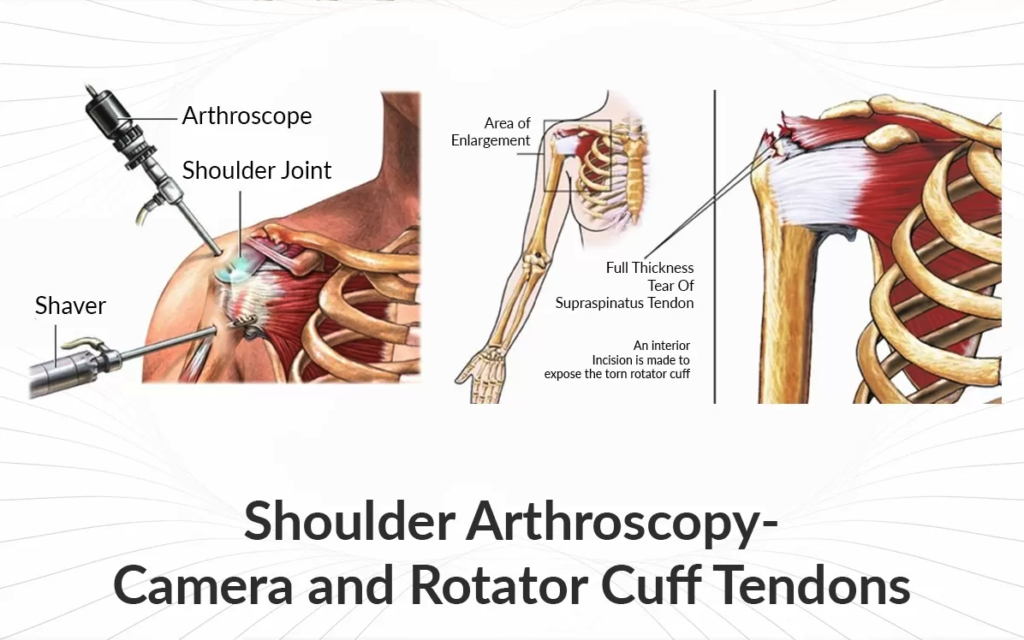
Going into any surgery can be scary, and there are always lots of things to consider. Feeling prepared when you walk in is nice, but wouldn’t it be even nicer if you could walk in AND out feeling completely prepared for your recovery and future?
We’ve had the pleasure of working alongside a shoulder surgeon, and we have therefore treated our fair share of people who have undergone a rotator cuff surgery.
Read on for all the ins and outs of a rotator cuff repair! There’s LOTS to know, and if you’re going to go through any surgery, it’s nice to feel prepared!
How do you know if you need rotator cuff surgery?
You need rotator cuff surgery if the following things are true (typically):
- You have significant shoulder pain that is greatly limiting your ability to complete your activities of daily living (i.e. get dressed, sleep, work)
- You have imaging results (i.e. an MRI) that show rotator cuff damage (and this damage is ‘fixable’ with surgery)
- You have tried to reduce your pain and improve your function through virtually every other conservative option, including a significant bout of physical therapy
- Conservative options include, but are not limited to: physiotherapy, massage therapy, chiropractic care, acupuncture, and injections
Should I do physiotherapy before my surgery?
In short, yes, you should. It helps in the following ways:
- Helps you understand what to expect with surgery and postoperatively
- Helps strengthen muscles to their maximum potential (not just rotator cuff muscles, but also neck, back, and other arm/shoulder muscles)
- Improves your range of motion to help limit stiffness in all associated joints
- In some cases, physiotherapy eliminates the need for surgery in the first place!
On this note, we wanted to mention a few other things.
Sometimes, your rotator cuff is injured from an accident, like a fall. Sometimes during these accidents, additional body parts, like our wrists (for example), are injured. Additionally, it’s possible that shoulder pain alone can cause us to alter our posture, stop moving, or over-protect other joints.
We strongly recommend that you properly rehabilitate all other injuries/pains/tight feelings as much as possible before surgery. Rehabilitation may include bouts of physical therapy, massage therapy, or self-management. Your body will be working very hard to heal your shoulder after surgery, so you’ll want to make sure it only has to worry about one single injury.
To reiterate the final point above, physiotherapy can eliminate the need for surgery in the first place! This is true even if your MRI shows a tear in your rotator cuff. In fact, this is even true if you rip a rotator cuff muscle clean off the bone. Everyone is an individual. Everyone’s body heals differently. Everyone has different goals. And, as many of you may remember, imaging findings DO NOT correlate with pain and function. Read more on that here.
What else should I do before rotator cuff surgery?
- Understand what you’re getting yourself into
- QUIT smoking (smoking can increase rotator cuff retear rates by up to 25%!)
- Eat well, and take steps to improve your overall health
- Organize assistance for after surgery (you’ll have trouble bathing, dressing, and cooking with just 1 arm!)
- Assistance may be needed for a couple of months – for example, you will not be allowed to drive for at least 6 weeks post-op.
What is a Rotator Cuff Surgery?
Every surgeon has their individual preferences, however most surgeons do arthroscopic rotator cuff repairs. Arthroscopic means that the surgeon will use a tiny camera called an arthroscope. The arthroscope is inserted into your shoulder via a fairly small incision. The tools required to fix your rotator cuff are inserted through additional small incisions. Therefore, you’ll likely only have a few small incisions around your shoulder!
To repair the rotator cuff muscle/tendons, the surgeon will use ‘sutures’ and ‘suture anchors’ (or ‘anchors’ for short). The sutures and anchors will help to hold tears together, or help to attach a torn tendon securely to the bone. These sutures and anchors are not removed. They are safe to stay in your shoulder for life.
Disclaimer:
Before we get into the next part of this blog post, it is important to note that everything in this blog post is for information purposes only. This blog post is not intended to be strict medical advice. As previously mentioned, everyone is an individual, and therefore, individual variances do occur. It is important to consult your physiotherapist, surgeon, or doctor for the most applicable advice for you.
What to Expect After your Rotator Cuff Surgery: The Recovery
Commonly, postoperative care looks something like this:
- You will wear a sling for at least 6 weeks. Morning and night. Wear it. It can come off to do physiotherapy exercises as instructed by your physiotherapist. Otherwise, it’s on. Seriously. Wear your sling. You don’t want to undo everything the surgeon just did.
- Under the supervision of a skilled physiotherapist, you will start rehab around weeks 2-4 post-op.
- Passive range of motion exercises for the shoulder (meaning the therapist moves your arm for you) usually start around week 4 post-op.
- You will learn to start moving your arm on your own around week 6 post-op (after the sling comes off!). Again, you will normally have to wait until week 6 post-op to move your arm on your own.
- Strengthening of your rotator cuff muscles must happen slowly, safely, and progressively, under the supervision of a physiotherapist. Usually, this starts (slowly), around weeks 8-10 post-op.
- All additional strengthening (i.e. for overhead work, sports, etc) is introduced only when deemed safe by the surgeon/physiotherapist, and will usually start no earlier than week 12 post-op.
How long does it take to heal after a rotator cuff repair surgery?
In uncomplicated cases,
- Surgical healing of your rotator cuff will take at least 8-12 weeks after surgery.
- Surgical healing does not mean full function. It means the surgical sites and sutures are likely physiologically healed.
- Full function will most likely take at least 9-12 months of rehabilitation. Progressive, safe, and necessary functional strength training exercises will take months to appropriately complete. It is normal for it to take a year for your shoulder to feel “normal”.
That last point carries some weight to it, and for many reasons! Due to the lengthy recovery associated with a rotator cuff repair surgery, here are some things to consider:
- You may be off work a long time, depending on your job (for example: if you have to lift heavy stuff overhead a lot, that will take time to re-learn!)
- Physiotherapy appointments will be necessary for a long time. Yes, the frequency of appointments will decrease over time, but it will be important to stick with your physiotherapy appointments for months.
- If you have private insurance coverage, that’s great! But keep in mind, depending on how much you have, it is not uncommon to use all of it, and then some.
- If you don’t have private insurance coverage, rehabilitation costs will be expensive.
- Couple this with being off work, and finances can be a significant added stress that many people do not consider!
- Be aware of the financial considerations associated with surgery.
What exercises are safe to do right away after a rotator cuff surgery?
Although you should not move or exercise your shoulder/rotator cuff muscles immediately after surgery (see above), there are a few things you can work on right away. See a physiotherapist and get started on exercises for:
- Your neck (for example: side to side stretches, rotation movements)
- Your shoulder blade (for example: shoulder blade clocks, shoulder squeezes)
- Your elbow (for example: gentle bend and straighten (with your elbow against your side))
- Your wrist and hand (for example: ball squeezes, wrist rotations)
- Your posture
Your physiotherapist can also work on many of these body parts for you. This should help to reduce any postoperative complications in your other joints, all while decreasing your pain!
How much function and how little pain can I expect at the end of my rehabilitation?
Alas, the loaded question.
Again, everyone is an individual, everyone heals differently, and therefore final pain and function is highly individualized.
Here are some things we consider:
- Number of anchors
- Approximately, anchors and range of motion are inversely related. This means that the more anchors needed to repair the damage, the less range of motion you can expect. If you have 3-4 anchors, it’s common to only get approximately 120 degrees of shoulder elevation by the end of rehab (but it hopefully won’t hurt!). If you have 1 anchor, you should get full range of motion in all planes, and it should be pain-free.
- How much pain did you have before surgery, and how long did you have that pain?
- Again, these can be related. If you were in absolute agony for 3 years before surgery, there will be a lot of additional things to consider when trying to reduce pain post-operatively. Pain has biopsychosocial components. See this awesome blog post on pain for more information.
- If you tore your rotator cuff from a one-off accident, got assessed quickly, started pre-operative physiotherapy, and received surgery fairly quickly, there should be fewer things limiting your overall recovery.
- What are your goals?
- If your goal is to lift 50 pounds overhead repetitively, your rehab will probably take longer than if your goal is to get yourself dressed and cook your own meals. Therefore, depending on your goals, your perception of your overall function will also change.
- That being said, set appropriate, attainable goals with your physiotherapist and work towards these goals!
What are the potential complications are there with rotator cuff surgery?
All steps will be taken to limit complications postoperatively, however, it’s important to understand the possibilities. Complications include:
- Infection. It’s important to follow the hospital’s instructions on keeping your incisions clean, and free of debris. Change your bandages as instructed, and take good care of your wounds.
- Keep an eye out for:
- Ill-smelling, discolored discharge coming from your wounds.
- If you’re running a fever, have a significant increase in pain, swelling, or redness around the shoulder.
- Keep an eye out for:
- Retearing. You may retear your surgically repaired rotator cuff. The rates of retear vary a lot depending on the research paper you read. In short, listen to your surgeon’s restrictions (i.e. wear your sling), follow the rehab protocol, and don’t rush your recovery.
Final words
There’s a lot of information in this blog post. But there’s also a lot to know. Be informed, ask questions (even the hard ones), and look out for yourself.
Let us know if you thought this blog post was helpful, and we will try to post new ones outlining the helpful points for other types of surgeries!
Do you have a rotator cuff injury and need to know more? At Strive Physiotherapy and Performance, we are committed to providing an in-depth assessment to ensure we can work together to find the best plan of action for each individual client. Call us at 519-895-2020, or use our online booking tool on www.strivept.ca to book an appointment with one of our knowledgeable physiotherapists, and they will be sure to help you understand your injury.
Take care,
Tyler Allen & Mike Major
Physiotherapists at Strive Physiotherapy and Performance
